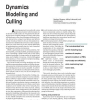Free Online Productivity Tools
i2Speak
i2Symbol
i2OCR
iTex2Img
iWeb2Print
iWeb2Shot
i2Type
iPdf2Split
iPdf2Merge
i2Bopomofo
i2Arabic
i2Style
i2Image
i2PDF
iLatex2Rtf
Sci2ools
CGA
1999
1999
Dynamics Modeling and Culling
emsintovirtualenvironments,whileabstracting the modeling process as much as possible. To achieve efficiency,weconcentrateoncullingdynamicalsystems: if the system is not in view, we do not compute any dynamics for it. As a concrete example of the benefits of culling, consider a museum of kinetic sculpture (such as mobiles). Such a world has a large number of dynamic objects-the exhibits--placed in mutually nonvisible rooms. Traditional dynamic simulation requires computing the motionofallthesculpturesoneveryframe,evenifsome sculptures aren't visible to the viewer. Naturally, this would severely limit the size of the museum. Culling avoids dynamic state computation for the exhibits not in view, just as geometry culling avoids rendering their geometry. Exploiting culling allows the museum to be arbitrarily large, provided only a few rooms are visible at once. Similar examples occur in factory simulations or dense city environments. In this article we describe three tools that togethe...
| Added | 22 Dec 2010 |
| Updated | 22 Dec 2010 |
| Type | Journal |
| Year | 1999 |
| Where | CGA |
| Authors | Stephen Chenney, Jeffrey Ichnowski, David A. Forsyth |
Comments (0)

